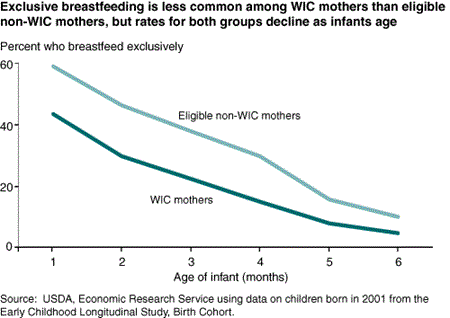WIC Infants Less Likely To Be Exclusively Breastfed

ERS and American University researchers found that women who participate in USDA’s Special Supplemental Nutrition Program for Women, Infants, and Children (WIC) are less likely than income-eligible nonparticipants to exclusively breast-feed their newborns. The American Academy of Pediatrics (AAP) recommends exclusive breastfeeding for an infant’s first 6 months and continued breastfeeding, with supple-mentation, until the infant is 12 months old. Recent changes to the types and amounts of foods provided through the WIC program, however, may increase breastfeeding rates of WIC mothers.
To be eligible for WIC, a pregnant or postpartum woman must have income below 185 percent of the poverty line or participate in an assistance program such as Medicaid. WIC provides postpartum women with nutritious food and, for those not exclusively breastfeeding, free infant formula.
WIC has always faced the challenge of promoting breastfeeding, while simultaneously providing infant formula to mothers who choose not to breastfeed. These dual objectives raise the concern that WIC itself may influence a participant’s breastfeeding choice. The high cost of infant formula provides a strong economic incentive to breastfeed. But when WIC provides the formula at no cost, that incentive is removed. Although the researchers used an approach that controlled for some of the factors and other incentives that influence the complex decision to breastfeed, study results do not establish a causal link between WIC and breastfeeding.
Researchers found that of children born in 2001, 43.6 percent of WIC mothers breastfed through the infant’s first month, compared with 59.2 percent of eligible non-WIC mothers. By 6 months, only 4.7 percent of WIC mothers and 9.9 percent of eligible non-WIC mothers breastfed exclusively. In a 2004 national survey, the U.S. Centers for Disease Control and Prevention found that 15 percent of mothers with incomes above 185 percent of the poverty line breastfed exclusively through 6 months.
While WIC participation is associated with lower rates of exclusive breastfeeding, the infant formula in the WIC package does provide low-income mothers with a nutritionally superior alternative to cow’s milk. The AAP recommends introducing cow’s milk no earlier than 12 months of age and solid foods no earlier than 6 months of age. ERS and American University researchers found that WIC mothers were more likely than eligible nonparticipants to adhere to the AAP guidelines to delay introducing cow’s milk. However, the researchers also found that WIC participants were more likely to introduce solid foods before 6 months, with about one-fourth of WIC mothers introducing solid foods by 4 months.
In 2009, the WIC food packages underwent the most substantial revision since the program began in 1974. While the previous package provided infant cereal at 4 months of age, the revised WIC package does not include solid foods until the infant is 6 months old. The new packages promote breastfeeding by providing a greater amount and variety of food in the WIC package for women who exclusively breastfeed. In addition, the new food package no longer includes formula for fully breastfed infants, and it provides a reduced amount of formula for partially breastfed infants.
“Special Supplemental Nutrition Program for Women, Infants, and Children and Infant Feeding Practices,”, ERS, February 2007, in Pediatrics, Vol. 119, No. 2, February 2007, pp. 281-289.


